The 50 Proposed Maxims of neuroELT
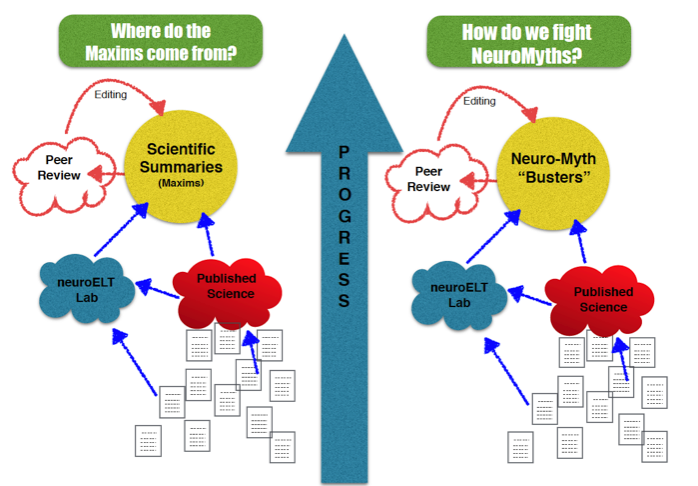
1. “Emotion” drives learning
As Damasio (1994) established two decades ago, emotion is not a sideline attraction in the brain, it is fundamental in all cognitive processing. In a nutshell, what excites the brain is what gets processed and therefore gains potential for future recall -- not a guarantee, but a potential for future recall. Moreover, boring information is often lost before any significant processing occurs in the brain. Therefore, the more emotion attached to learning, the more potential it has have being useful in the future.
What is the difference between emotion and feelings? From the neuro-educator's perspective, think of emotion as the body's automatic reaction to stimuli. and of feelings are the results derived from higher level thinking. These two quite often clash and are the cause of confusion and in severe cases, mental illnesses.
Q. Do you understand the emotion vs feelings dichotomy and see why this maxim makes sense?
As Damasio (1994) established two decades ago, emotion is not a sideline attraction in the brain, it is fundamental in all cognitive processing. In a nutshell, what excites the brain is what gets processed and therefore gains potential for future recall -- not a guarantee, but a potential for future recall. Moreover, boring information is often lost before any significant processing occurs in the brain. Therefore, the more emotion attached to learning, the more potential it has have being useful in the future.
What is the difference between emotion and feelings? From the neuro-educator's perspective, think of emotion as the body's automatic reaction to stimuli. and of feelings are the results derived from higher level thinking. These two quite often clash and are the cause of confusion and in severe cases, mental illnesses.
Q. Do you understand the emotion vs feelings dichotomy and see why this maxim makes sense?
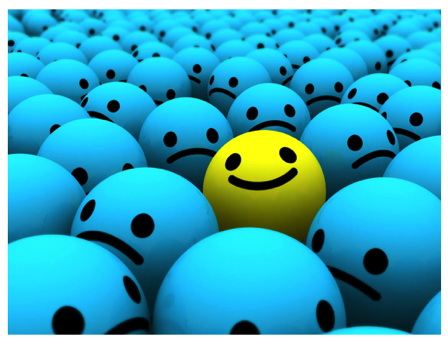
“Emotion” drives learning
2. “Intelligence” is overrated
Gardner (1983) began a revolution regarding what intelligence is, and questioned if it can actually be represented by a single IQ number (or G-factor). Whether his Multiple Intelligences theory is correct is irrelevant —with Fischer’s Dynamic Skill Theory (1980), it becomes obvious that although humans can display optimal levels of cognition that can be tested for, we usually only perform at our functional levels. This means that intelligence tests that are not conducted in optimal contexts can provide only dubious results. In fact, it is highly questionable if there can be a standardized system for testing intelligence, because intelligence is domain specific, therefore, it is much too elusive for standardized testing formats. This flows into the next maxim.
Q. How has the IQ test influenced your thinking regarding intelligence? What do you think about it now?
Gardner (1983) began a revolution regarding what intelligence is, and questioned if it can actually be represented by a single IQ number (or G-factor). Whether his Multiple Intelligences theory is correct is irrelevant —with Fischer’s Dynamic Skill Theory (1980), it becomes obvious that although humans can display optimal levels of cognition that can be tested for, we usually only perform at our functional levels. This means that intelligence tests that are not conducted in optimal contexts can provide only dubious results. In fact, it is highly questionable if there can be a standardized system for testing intelligence, because intelligence is domain specific, therefore, it is much too elusive for standardized testing formats. This flows into the next maxim.
Q. How has the IQ test influenced your thinking regarding intelligence? What do you think about it now?
3. “Cognition” is context dependent.
Because, unlike computers, context directly changes human excitement (motivation) regarding any task at hand, it necessarily affects our cognition and therefore affects all cognitive output. In contrast, computer results do not change with the weather; human outcomes do change with the weather, although our pride may not want us to admit the truth regarding our organic and contextually subjective nature. Use our human “context dependency” to your advantage in the classroom.
Q. Think about how context affects your own cognition. Where do you do your best work? Identify things that affect your performance.
Because, unlike computers, context directly changes human excitement (motivation) regarding any task at hand, it necessarily affects our cognition and therefore affects all cognitive output. In contrast, computer results do not change with the weather; human outcomes do change with the weather, although our pride may not want us to admit the truth regarding our organic and contextually subjective nature. Use our human “context dependency” to your advantage in the classroom.
Q. Think about how context affects your own cognition. Where do you do your best work? Identify things that affect your performance.

“Cognition” is context dependent.
4. “Learning” is not understanding.
In psycho-neuroscientific terms, learning is the ability to compound enough reflex network sets in the brain to create a higher level of cognition. An easy example is learning balanced walk. A huge number of reflex sets including reflex sets from the eyes, ears, feet, arms, and torso must compound to form the act of balanced walk. The ability to compound smaller reflex sets into larger, more convoluted reflex sets demonstrates the ability to learn. This type of learning does not equate to understanding. Does the child who just learned to walk actually understand the ergonomics or the physics of walking? No, the child does not. It is the same for all human learning. Understanding is a much more taxing process that requires more time and motivation than simplistic learning does.
Q. In your own words, explain the learning vs understanding dichotomy.
In psycho-neuroscientific terms, learning is the ability to compound enough reflex network sets in the brain to create a higher level of cognition. An easy example is learning balanced walk. A huge number of reflex sets including reflex sets from the eyes, ears, feet, arms, and torso must compound to form the act of balanced walk. The ability to compound smaller reflex sets into larger, more convoluted reflex sets demonstrates the ability to learn. This type of learning does not equate to understanding. Does the child who just learned to walk actually understand the ergonomics or the physics of walking? No, the child does not. It is the same for all human learning. Understanding is a much more taxing process that requires more time and motivation than simplistic learning does.
Q. In your own words, explain the learning vs understanding dichotomy.
5. “Understanding” is the synthesis of and ability to apply prior learning.
Learning comes before understanding. Understanding requires the synthesis of concepts that surround the learning process and include the incorporation of dynamic skills that allow the learning to be applied in other situations in the real world. A simple example — you can learn how to verbalize a sentence in a second language, but until you know how to use it in real world contexts by being able to feel the nuances of when it is appropriate or not, you do not truly understand the sentence. Understanding is therefore a much more convoluted process that should never be mistaken for the simplistic process of learning, although this is often the case in formal learning contexts, and common tests. Unlike simplistic learning, understanding takes nurturing time and creative ingenuity to be able to apply it to real world situations. From the brain's perspective, true understanding is an astronomical jump up from learning.
Q. What is something that you "understand"? Discuss why you can say that you "understand" it deeply?
Learning comes before understanding. Understanding requires the synthesis of concepts that surround the learning process and include the incorporation of dynamic skills that allow the learning to be applied in other situations in the real world. A simple example — you can learn how to verbalize a sentence in a second language, but until you know how to use it in real world contexts by being able to feel the nuances of when it is appropriate or not, you do not truly understand the sentence. Understanding is therefore a much more convoluted process that should never be mistaken for the simplistic process of learning, although this is often the case in formal learning contexts, and common tests. Unlike simplistic learning, understanding takes nurturing time and creative ingenuity to be able to apply it to real world situations. From the brain's perspective, true understanding is an astronomical jump up from learning.
Q. What is something that you "understand"? Discuss why you can say that you "understand" it deeply?
“Understanding” is the synthesis of and ability to apply prior learning.
6. “Reflexes” compound into action skills.
The basis of all learning/understanding is skill development. But what are skills? Skills are compounded reflex sets. A simple twitching reflex can and does compound into more complex, coordinated movement. These latter compound into more complex skills such as swatting a fly, and drawing with crayons. Language learning, as a skill, also goes through the same processes of development. It begins with reflexes such as sound recognition, and builds into word recognition, and then sentence recognition.
Q. Identify a set of reflexes that you may have processed into action skills. Discuss your thoughts on the trip you made from reflexes to actions.
The basis of all learning/understanding is skill development. But what are skills? Skills are compounded reflex sets. A simple twitching reflex can and does compound into more complex, coordinated movement. These latter compound into more complex skills such as swatting a fly, and drawing with crayons. Language learning, as a skill, also goes through the same processes of development. It begins with reflexes such as sound recognition, and builds into word recognition, and then sentence recognition.
Q. Identify a set of reflexes that you may have processed into action skills. Discuss your thoughts on the trip you made from reflexes to actions.

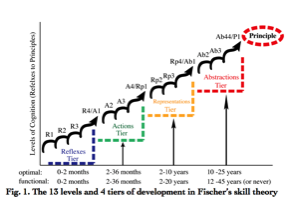
7. “Skills” compound into representations (and then abstract thoughts).
Humans have the unique capacity of forming abstractions — as far as we can tell, only humans reach this level of cognition. By abstractions, I mean the usage of metaphors such as liberty, justice, and even art. Can toddlers understand liberty, justice, and art the same way adults can? No, they cannot. After they have fostered many skills across many different domains, children from around the age of two begin to form concrete representations — that is, skillful word choice that represent their current higher level skill sets. From then on these higher level skill sets and their verbal representations become intertwined and mostly inseparable from each other. This is the phenomenon of first language acquisition (and balanced multilingualism, if acquisition begins at these young ages). When sets and complex systems of representations form their own sets and systems, they become abstractions. This level of complexity is beyond animals and toddlers. Humans only begin to form abstractions around the age of 12 and beyond. It takes that long for the brain to prepare the groundwork for abstract level cognition. This leads into the next maxim.
Q. Identify a set of actions that you may have processed into representations. Discuss your thoughts on the trip you made from actions to representations.
Humans have the unique capacity of forming abstractions — as far as we can tell, only humans reach this level of cognition. By abstractions, I mean the usage of metaphors such as liberty, justice, and even art. Can toddlers understand liberty, justice, and art the same way adults can? No, they cannot. After they have fostered many skills across many different domains, children from around the age of two begin to form concrete representations — that is, skillful word choice that represent their current higher level skill sets. From then on these higher level skill sets and their verbal representations become intertwined and mostly inseparable from each other. This is the phenomenon of first language acquisition (and balanced multilingualism, if acquisition begins at these young ages). When sets and complex systems of representations form their own sets and systems, they become abstractions. This level of complexity is beyond animals and toddlers. Humans only begin to form abstractions around the age of 12 and beyond. It takes that long for the brain to prepare the groundwork for abstract level cognition. This leads into the next maxim.
Q. Identify a set of actions that you may have processed into representations. Discuss your thoughts on the trip you made from actions to representations.

8. “Cognitive development” is age range dependent and domain specific.
Dynamic Skill Theory (Fig. 1) scientifically lays out the ages at which new cognitive potential arrives. Cognitive development is therefore age dependent. Due to the popularity of IQ tests, it is common to assume that a single intelligence quotient can sum up the cognitive development of any individual. This is non-sensical. It is non-sensical because cognition is not only age range dependent, but it is domain specific — that is, one person’s cognitive development in the domain of ‘Math’ has little to do with their cognitive development in ‘History’ or ‘English’, or any other non-related subject. Each domain fosters its own ‘tree of knowledge’ in the brain, so to speak. There is of course overlap where needed. Indeed, creativity stems from and depends upon cross-domain overlap. It is much like the cross-fertilization that occurs across real trees and plants in the wild that brings upon natural variability. However, for the most part, it is more useful to realize that cognitive development occurs per domain, independently. In this sense, our brains are like our very own eco-system; different areas grow plants and trees in different ways, yet they all dynamically affect each other, cross-fertilize each other when possible, and they all grow within natural cyclical parameters.
Q. Cynics (and perhaps overly conceited people) may disagree with this maxim on a very personal level. They may find it hard to believe that their cognition fell into a set pattern along with other humans. What are your thoughts on this?
Dynamic Skill Theory (Fig. 1) scientifically lays out the ages at which new cognitive potential arrives. Cognitive development is therefore age dependent. Due to the popularity of IQ tests, it is common to assume that a single intelligence quotient can sum up the cognitive development of any individual. This is non-sensical. It is non-sensical because cognition is not only age range dependent, but it is domain specific — that is, one person’s cognitive development in the domain of ‘Math’ has little to do with their cognitive development in ‘History’ or ‘English’, or any other non-related subject. Each domain fosters its own ‘tree of knowledge’ in the brain, so to speak. There is of course overlap where needed. Indeed, creativity stems from and depends upon cross-domain overlap. It is much like the cross-fertilization that occurs across real trees and plants in the wild that brings upon natural variability. However, for the most part, it is more useful to realize that cognitive development occurs per domain, independently. In this sense, our brains are like our very own eco-system; different areas grow plants and trees in different ways, yet they all dynamically affect each other, cross-fertilize each other when possible, and they all grow within natural cyclical parameters.
Q. Cynics (and perhaps overly conceited people) may disagree with this maxim on a very personal level. They may find it hard to believe that their cognition fell into a set pattern along with other humans. What are your thoughts on this?
9. "Knowledge" is non-transferable.
As can be seem from the maxims above, learning, understanding, and therefore knowledge is organic and dynamic. The brain must be nurtured in the specific domains that are about to be learned and hopefully understood. Therefore, it becomes obvious that knowledge cannot be transferred verbatim, or downloaded from one person to the next as if they were connected by computer cables because there is no compatibility between brains to allow this to happen. Why? Each learner creates unique neuro-pathways and convoluted networks in their own brains in accord with the real-time mappings that exist in their individual brains at any given moment. It is all very unique and proprietary. This means that each learner’s internal learning experience is necessarily uniquely different across brains, but even on an second-by-second basis within a single brain. Changes do happen that quickly. In short, regardless of the learning context, any form of knowledge that exists in one person can never be transferred verbatim to another person because of huge biological differences, and because knowledge itself is dynamic in nature — it is never concrete in any single person’s brain. This why computers can so good at top-down rote-learning, but humans are notoriously bad at it.This also leads in to the next maxim.
Q. Another die-hard human conceit -- transfer of knowledge. As teachers, we must accept that nothing we teach will transfer from our brains into our students' brains verbatim. How does that make you feel? What changes to your teaching should you consider along with this maxim?
As can be seem from the maxims above, learning, understanding, and therefore knowledge is organic and dynamic. The brain must be nurtured in the specific domains that are about to be learned and hopefully understood. Therefore, it becomes obvious that knowledge cannot be transferred verbatim, or downloaded from one person to the next as if they were connected by computer cables because there is no compatibility between brains to allow this to happen. Why? Each learner creates unique neuro-pathways and convoluted networks in their own brains in accord with the real-time mappings that exist in their individual brains at any given moment. It is all very unique and proprietary. This means that each learner’s internal learning experience is necessarily uniquely different across brains, but even on an second-by-second basis within a single brain. Changes do happen that quickly. In short, regardless of the learning context, any form of knowledge that exists in one person can never be transferred verbatim to another person because of huge biological differences, and because knowledge itself is dynamic in nature — it is never concrete in any single person’s brain. This why computers can so good at top-down rote-learning, but humans are notoriously bad at it.This also leads in to the next maxim.
Q. Another die-hard human conceit -- transfer of knowledge. As teachers, we must accept that nothing we teach will transfer from our brains into our students' brains verbatim. How does that make you feel? What changes to your teaching should you consider along with this maxim?
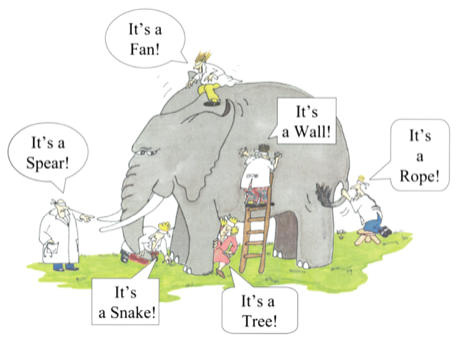
"Knowledge" is non-transferable.
10. “Memory” is a process (and myth and a metaphor)
Knowledge is never concrete in the brain — it is a dynamic and organic. Knowledge is fleeting and must be often rekindled for longterm usage. However, knowledge is closely synonymous with ‘memory’. How can memory be concrete if knowledge is not concrete? If memory is not concrete, then memory itself, at least the popular opinion of what memory is, cannot really exist.
What is memory? Memory is a communal metaphor for an ever-growing number of human capabilities that we use to describe our skills that we use in demonstrating our knowledge and/or understanding of the world. Because it is a skill, it is therefore a process, not something tangible like computer RAM. Our memory is very much NOT book-like nor computer RAM-like; our memory changes with context. Moreover, it changes every time we use it. ‘Memory’ is the result of real time cognition derived from lingering neural networks — certainly not from concrete storage banks. Whatever networks that happen to be lingering at the time of cognition necessarily affects the real-time re-membering process. By referring to memory as a myth (and metaphor), we allow for a better representation of the actual real-time neural processes.
Remember, your memory is usually only as good as your last recall -- and even then, you are at the mercy of your own real-time deductive and inductive skills regarding it. Memory is not a time machine. Memory is a "now process", meaning that it is present and future oriented. This may be counterintuitive. Read Dan Schacter's work at his Memory Lab at Harvard for more juicy details! Memory is about predicting the future. See also Moshe Bar's work: Predictions in the Brain.
Q. This is an uncomfortable maxim for many people. How does make you feel? What changes to your teaching should you consider? How should you convey this to your students?
Knowledge is never concrete in the brain — it is a dynamic and organic. Knowledge is fleeting and must be often rekindled for longterm usage. However, knowledge is closely synonymous with ‘memory’. How can memory be concrete if knowledge is not concrete? If memory is not concrete, then memory itself, at least the popular opinion of what memory is, cannot really exist.
What is memory? Memory is a communal metaphor for an ever-growing number of human capabilities that we use to describe our skills that we use in demonstrating our knowledge and/or understanding of the world. Because it is a skill, it is therefore a process, not something tangible like computer RAM. Our memory is very much NOT book-like nor computer RAM-like; our memory changes with context. Moreover, it changes every time we use it. ‘Memory’ is the result of real time cognition derived from lingering neural networks — certainly not from concrete storage banks. Whatever networks that happen to be lingering at the time of cognition necessarily affects the real-time re-membering process. By referring to memory as a myth (and metaphor), we allow for a better representation of the actual real-time neural processes.
Remember, your memory is usually only as good as your last recall -- and even then, you are at the mercy of your own real-time deductive and inductive skills regarding it. Memory is not a time machine. Memory is a "now process", meaning that it is present and future oriented. This may be counterintuitive. Read Dan Schacter's work at his Memory Lab at Harvard for more juicy details! Memory is about predicting the future. See also Moshe Bar's work: Predictions in the Brain.
Q. This is an uncomfortable maxim for many people. How does make you feel? What changes to your teaching should you consider? How should you convey this to your students?
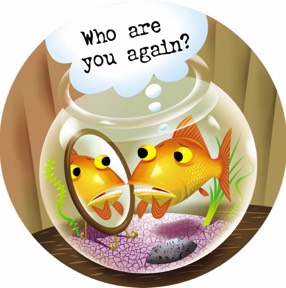
Do we really have "memory"?




